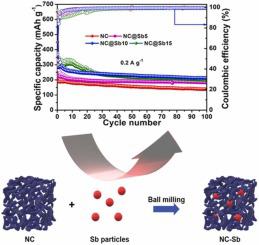当前位置:
X-MOL 学术
›
J. Alloys Compd.
›
论文详情
Our official English website, www.x-mol.net, welcomes your feedback! (Note: you will need to create a separate account there.)
Nitrogen-doped carbon with antimony nanoparticles as a stable anode for potassium-ion batteries
Journal of Alloys and Compounds ( IF 6.2 ) Pub Date : 2024-03-18 , DOI: 10.1016/j.jallcom.2024.174161 Hyeong-Seo Ki , Aqsa Nazir , Hang T.T. Le , Geon-Chang Song , Jaekook Kim , Chan-Jin Park
Journal of Alloys and Compounds ( IF 6.2 ) Pub Date : 2024-03-18 , DOI: 10.1016/j.jallcom.2024.174161 Hyeong-Seo Ki , Aqsa Nazir , Hang T.T. Le , Geon-Chang Song , Jaekook Kim , Chan-Jin Park

|
Potassium-ion batteries are considered promising alternatives to lithium-ion batteries (LIBs) because they have a lower redox K/K potential, a lower Stokes radius, abundant raw materials, and economic benefits. However, K has a larger ionic radius than Li, which may limit the diffusion of K ions into electrodes and cause poor electrode rate capability and cycling stability. In this study, N-doped C and Sb (NC@Sb) composites were synthesised using a facile and cost-effective method of carbonisation and ball milling. The NC@Sb composites had an interconnected and highly porous structure, which was formed by the release of gases such as CO, HO, CO, and NH during carbonisation. Additionally, NC@Sb is a promising anode owing to the synergistic effects of the high specific capacity of Sb and the good cycling stability of NC. In particular, the NC@Sb composite that contained 10 wt% Sb (NC@Sb10) exhibited a high reversible capacity of 264 mAh g after 100 cycles at a specific current of 200 mA g. Furthermore, the NC@Sb10 electrode maintained 85% of its initial capacity at a high specific current of 1 A g even after 500 discharge–charge cycles. The excellent electrochemical performance of the NC@Sb composite is mainly attributed to the stable embedding of the Sb nanoparticles in the porous and electrically conductive NC matrix, which can buffer Sb stress and provide a pathway for the penetration of the electrolyte and K ions.
中文翻译:

掺氮碳与锑纳米粒子作为钾离子电池的稳定阳极
钾离子电池被认为是锂离子电池(LIB)的有前途的替代品,因为它们具有较低的氧化还原K/K电势、较低的斯托克斯半径、丰富的原材料和经济效益。然而,K的离子半径比Li大,这可能会限制K离子扩散到电极中,导致电极倍率性能和循环稳定性较差。在这项研究中,使用一种简便且经济高效的碳化和球磨方法合成了氮掺杂碳和锑(NC@Sb)复合材料。 NC@Sb 复合材料具有互连且高度多孔的结构,该结构是通过碳化过程中释放 CO、H2O、CO 和 NH 等气体而形成的。此外,由于Sb的高比容量和NC良好的循环稳定性的协同效应,NC@Sb是一种很有前景的负极。特别是,含有10 wt% Sb的NC@Sb复合材料(NC@Sb10)在200 mA g-1的比电流下循环100次后表现出264 mAh g-1的高可逆容量。此外,即使在 500 次充放电循环后,NC@Sb10 电极在 1 A g-1 的高比电流下仍能保持其初始容量的 85%。 NC@Sb复合材料优异的电化学性能主要归功于Sb纳米粒子稳定嵌入多孔导电NC基体中,可以缓冲Sb应力并为电解质和K离子的渗透提供通道。
更新日期:2024-03-18
中文翻译:

掺氮碳与锑纳米粒子作为钾离子电池的稳定阳极
钾离子电池被认为是锂离子电池(LIB)的有前途的替代品,因为它们具有较低的氧化还原K/K电势、较低的斯托克斯半径、丰富的原材料和经济效益。然而,K的离子半径比Li大,这可能会限制K离子扩散到电极中,导致电极倍率性能和循环稳定性较差。在这项研究中,使用一种简便且经济高效的碳化和球磨方法合成了氮掺杂碳和锑(NC@Sb)复合材料。 NC@Sb 复合材料具有互连且高度多孔的结构,该结构是通过碳化过程中释放 CO、H2O、CO 和 NH 等气体而形成的。此外,由于Sb的高比容量和NC良好的循环稳定性的协同效应,NC@Sb是一种很有前景的负极。特别是,含有10 wt% Sb的NC@Sb复合材料(NC@Sb10)在200 mA g-1的比电流下循环100次后表现出264 mAh g-1的高可逆容量。此外,即使在 500 次充放电循环后,NC@Sb10 电极在 1 A g-1 的高比电流下仍能保持其初始容量的 85%。 NC@Sb复合材料优异的电化学性能主要归功于Sb纳米粒子稳定嵌入多孔导电NC基体中,可以缓冲Sb应力并为电解质和K离子的渗透提供通道。



























 京公网安备 11010802027423号
京公网安备 11010802027423号